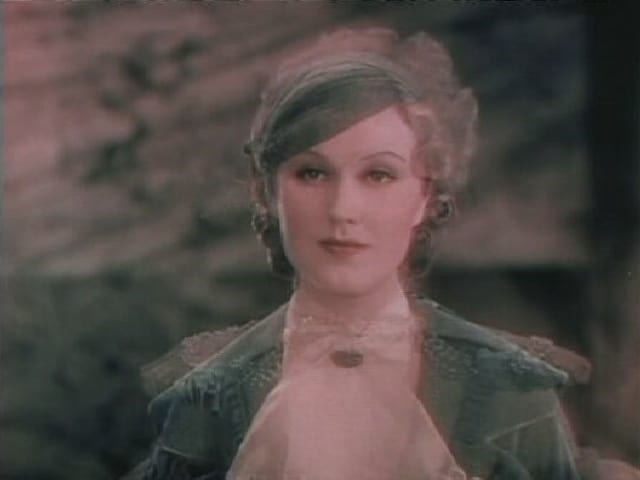
-screenshot.jpg)
The color printing process used by Technicolor from 1920 to 1927 involved printing the two color records on separate strips of film: most commonly, one with blue-green dye and one with red-orange. If you look closely, you can occasionally spot very slight eye movements in the actors posing as the sculptures. In Mystery of the Wax Museum, the heat necessitated the use of real people in place of wax sculptures, since the wax would have melted.

The process required extremely bright lights, resulting in hot temperatures on the set and even eye damage to many actors during that period. The film camera recorded two adjacent frames simultaneously on a single strip of film, one frame filtered to capture the green color record and the other filtered to capture the red. Although it is often referred to as "two-strip Technicolor," the actual photographic process, which was developed in 1920, used a single black-and-white negative.

The lighting by master cinematographer Ray Rennahan and the frequently abstract set designs by Anton Grot, combined with the restricted tonalities inherent to the color process, create an eerie atmosphere reminiscent of German Expressionism.
.jpg)
Produced in the fall of 1932 and released in February 1933, Mystery of the Wax Museum was the last feature film to be shot in the Technicolor two-color process, and it represents one of the most effective uses of it in terms of visual design. They uncover a lurid world of junkies, disfigured human monsters and maniacal schemes behind the walls of the wax museum. When Florence notices that one of the new sculptures in the museum bears a suspicious resemblance to Joan Gale, she decides to investigate further and enlists the help of Winton. Her roommate Charlotte (Fay Wray) happens to be the fiancée of Ralph Burton (Allen Vincent), a sculptor working in Mr. Her rich boyfriend George Winton (Gavin Gordon) is accused of the crime, but the sharp-tongued reporter Florence Dempsey (Glenda Farrell) sets out to prove his innocence when Joan Gale's body disappears from the morgue. On New Year's Eve, the beautiful Joan Gale (Monica Bannister) is found dead from an overdose of opiates. Twelve years later, he has relocated to New York and is preparing to open a new museum, though he is now wheelchair-bound and his hands are crippled. Trapped inside, Igor (Lionel Atwill) watches his priceless work melt away. Igor's artistically accomplished but poorly attended wax museum in London is set on fire by his backer, who wants to collect the insurance money in order to recoup his losses. Florence gets her story and a surprise proposal from Jim, her editor. He struggles with Igor, who falls into a vat of wax and dies. She screams in response, and hearing her cries, Ralph breaks into the museum. He plans to immortalize Charlotte as Marie Antoinette. He tells her that because his hands were damaged in the fire, preventing him from sculpting, he has been killing people who resemble his burned statues, and once they are dipped in wax, he displays them. Meanwhile, Igor has trapped Charlotte in the museum. When Winton is released from prison on bail, he and Florence follow Igor's drug addict assistant, Sparrow, hoping to find out the truth about the museum. There, Florence is struck by the resemblance between a wax statue of Joan of Arc and the dead Joan Gale. She accompanies her roommate Charlotte Duncan to Igor's new wax museum to visit Charlotte's fiancé Ralph Burton, Igor's assistant. Wisecracking reporter Florence Dempsey decides she will prove Winton's innocence. Her rich young boyfriend, George Winton, is arrested for her murder, but when an autopsy is ordered, the police find the body has been stolen. Twelve years later in New York, Igor watches from his window while the body of Joan Gale is taken to the morgue. Igor is trapped in the flames and all his work is destroyed. Igor's critically successful wax museum is burned down by his partner for the insurance money.


 0 kommentar(er)
0 kommentar(er)
